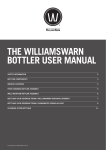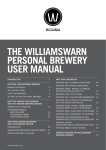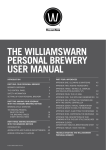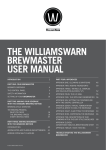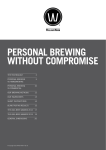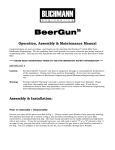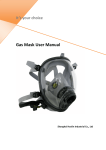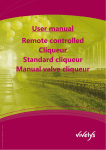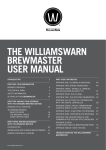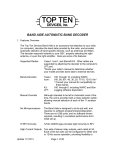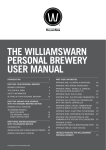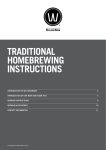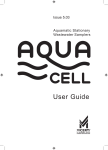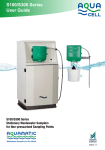Download THE WILLIAMSWARN boTTLER uSER MANuAL
Transcript
THE WILLIAMSWARN bottler user manual SAFETY INFORMATION 2 INTRODUCTION3 Manual cleaning 4 Installing the WilliamsWarn Bottler 5 Bottling your Beverage 6 Cleaning after bottling 7 © Copyright 2013 Nanobrewing Limited SAFETY INFORMATION These instructions for use outline general safety guidelines for the correct operation of the WilliamsWarn® Bottler. General Safety 1. It is the responsibility of the operator to read and understand the manual and other (safety) information. Always retain the manual as reference. 4. If for any reason the WilliamsWarn Bottler malfunctions, please contact WilliamsWarn. Cleaning and Maintenance 1. Always clean following the instructions in this manual and the WilliamsWarn Personal Brewery User Manual. 2. Never use the WilliamsWarn Bottler for any purpose other than the 'Intended Purpose'. Do not misuse, modify or force the appliance in any way as damage may occur that may create potential hazardous risks or situations. 2. We recommend the use of WilliamsWarn Brewery Detergent and WilliamsWarn Sodium Percarbonate as the detergent and sanitising agents respectively. If other products are used they should be approved brands of dishwashing detergent and approved brands of homebrewing sanitizer that are available commercially for these purposes. 3. Don’t use the WilliamsWarn Bottler in uncovered outdoor areas (without a canopy or overhang). 4. Always check if all the components of the WilliamsWarn Bottler are in place before using the device. 3. Dispose of the WilliamsWarn Bottler packaging material in the appropriate waste containers. 5. This device is not intended for use by persons (including children) with reduced physical, sensory or mental capabilities, or lack of experience and knowledge, unless they have been given supervision or instruction concerning use of the appliance by a person responsible for their safety. 4. When the WilliamsWarn Bottler reaches the end of its useful life it must be disposed of in a responsible manner, thereby ensuring the reuse of parts. 6. Use solely accessories recommended by the supplier. The use of other accessories may result in damage to the WilliamsWarn Bottler, thereby creating hazards for the user. Important The manufacturer isn’t responsible for any damage caused through: 7. When the WilliamsWarn Bottler is not in use store it in a dry place out of reach of children. 1. Improper handling and use for other purposes than the WilliamsWarn Bottler’s intended purpose. INTENDED PURPOSE 1. The intended purpose of the WilliamsWarn Bottler is to bottle cold, clear, perfectly carbonated, professional quality beverage. 2. Repairs executed by an unauthorized repairer. 3. The use of non-original components or accessories. For further information or in case of problems not mentioned in this manual you can see our website: www.williamswarn.com or send an e-mail to [email protected] COMPONENTS 1. The complete WilliamsWarn Bottler includes dispense valve, frame, bottle filling tube, beverage and CO2 line, 4mm allen key and six mounting screws. INSTALLATION, STORAGE AND OPERATING CONDITIOn 1. Mount the WilliamsWarn Bottler upright on a vertical, flat and stable surface. Make sure it doesn’t block a passage; it should be able to stay on the same location for a long period of time. 2. Use WilliamsWarn Bottler at an ambient temperature between 5°C (41°F) and 40ºC (104°F). 3. The WilliamsWarn Bottler should only be used with product intended for human consumption. Do not use with hazardous or poisonous substance. 2 INTRODUCTION The WilliamsWarn® Bottler enables you to bottle your own cold, clear, perfectly carbonated, professional quality beverage in a fast and easy way. This bottler is the ideal addition to your WilliamsWarn® Personal Brewery. The Bottler can accomodate bottles up to approximately 370mm in height, allowing a variety of bottle types to be used. The Bottler will allow you to fill the bottle with CO2 before filling it up, making sure your beverage doesn’t lose its freshness and carbonation when transferred to the bottle. 7 1 2 3 4 8 6 5 1. Beverage port 4.VARIABLE PRESSURE RELIEF VALVE (VPRV) 7. Beverage and CO2 line tubes 2.CO2 PORT 5. frame 3. dispense valve 6.bottle filling tubE, Beverage, and CO2 line tubes 8. 4MM ALLEN KEY AND SIX MOUNTING SCREWS 3 MANUAL CLEANING Before you install the WilliamsWarn® Bottler, it needs to be thoroughly cleaned. This removes any leftover residues from manufacturing. cleaning procedure A. Remove the dispense valve from the frame. See Figure 1. Fig. 1 B. Use the Allen key to take the dispense valve apart. See Figure 2. C. Take out all the O-rings (there will be 7 in total; 5 small, and 2 large). See Figure 3. D. Fill a bowl or jug with 1 litre of warm water and add 1 teaspoon of WilliamsWarn Brewery Detergent or any common dishwasher detergent. Place all components in the soapy water and let them soak for a minute or two. E. Use a dishwashing brush to clean all components thoroughly. F. Rinse all components with water. Fig. 2 G. Dry all components and re-assemble the valve. Fig. 3 4 Installing the WilliamsWarn Bottler A. The WilliamsWarn Bottler needs to be installed upright and well fastened to a rigid structure at a convenient height. Fig. 4 Fig. 5 Fig. 6 Fig. 7 Fig. 8 Fig. 9 Install the WilliamsWarn bottler close to your brewery, approximately 1-2 m’s away from the WilliamsWarn Personal Brewery or where the brewery can be moved to easily. B. When the Frame is mounted and installed firmly, slide the dispense valve in the slot of the frame. See Figure 4. Secure it with the o-ring. See Figure 5. C. Push the CO2 line (black line) into the fitting on the right (front on, see Figure 6). Push the line down hard and then pull back gently to ensure it is locked into place. D. Push the Beverage line (clear line) into the fitting on the left (front on, see Figure 7). Again, push the line down hard and then pull back gently to ensure it is locked into place. E. Connect the Beverage line (clear line) into the brewery filling line valve at the back of the Draft Tap Font. See Figure 8. F. In the same manner connect the CO2 line (black line) into the CO2 line valve coming from the back of the Draft Tap Font. See Figure 9. 5 Bottling your Beverage Fig. 10 Fig. 11 The WilliamsWarn Bottler is an easy to operate device, so anybody will be able to bottle. All you need to do are the following steps: 1. Set the WilliamsWarn Bottler to the right size for the type of bottle you want to fill. The minimum size of the bottle is 20cm (±8 inches) and the maximum size is 37cm (±14.5 inches). 2. Cut the filler tube so that it ends up at the bottom of the bottle when the bottle is in the bottler. See Figure 10. Fig. 12 3. Place a bottle in the WilliamsWarn Bottler; ensure the plastic bung seals the bottle entry well, to do this the bottler bracket will need to be set smaller than the bottle height. This will ensure that the flex in the bottom part of the bracket will keep tension on the bottle and the bung. See Figure 11. Fig. 13 4. Make sure the handle of the dispense valve is in the neutral position (in line with the variable pressure relief valve). See Figure 12. Fig. 14 5. Open the brewery filling line valve at the back of the Draft Tap Font. Make sure the unit is pressurized (1-1.5 bar). See Figure 13. Fig. 15 6. Open the CO2 line valve at the back of the Draft Tap Font. See Figure 14. 7. Move the dispense valve handle towards you for a few seconds, you will hear the CO2 flow into the bottle and escaping out of the VPRV (Variable Pressure Relief Valve). See Figure 15. If you don't hear gas escape out of the VPRV, turn the VPRV anti-clockwise until you do. See Figure 17. Fig. 16 8. Move the dispense valve handle away from you, you’ll see the beverage flowing into the bottle. See Figure 16. Fig. 17 9. Adjust the variable pressure relief valve so that the beverage fills the bottle gently. You can slow the fill speed by turning the VPRV clockwise. You can speed the fill up by turning the VPRV anti-clockwise. See Figure 17. For a 500mL bottle, a typical fill speed, to ensure no foaming and no loss of carbonation, would be about 45 seconds. So for a 330mL bottle, a 30 second filling time would be about optimal. You may find your own technique and filling time and that is fine. Fig. 18 10.When the bottle is almost full, with about 1/3 of the neck as headspace, close the valve handle back to the neutral position (in line with the VPRV). Leaving some headspace (which is CO2) will prevent spillage when removing the bottle. See Figure 18. Fig. 19 11.Remove the bottle from the WilliamsWarn Bottler and close the lid as soon as possible to prevent air getting into the bottle. See Figure 19. 12.Go back to step 3 and repeat the bottling procedure as many times as need be. 6 Cleaning after bottling If you empty your WilliamsWarn Bottler by bottling all the beverage you can clean the bottler as part of the brewery clean. However it is optimal to first close the two valves on the back of the draft tap font and dismantle the bottler valve as described in the section "Manual Cleaning". Then give the components a good rinse under running water. Then reassemble the valve and reconnect the beverage and C02 lines to the bottler valve and the brewery valves on the draft tap font ready for the cleaning Stage 1, as described in the Personal Brewery User Manual. If you have only filled a few bottles and the brewery still contains beverage and therefore cannot be cleaned, then the bottler should be cleaned seperately. hey ian, just rephrased this text in the last section as it felt a little disjointed in your notes. let me know what you think. would have rung but its quite late. Close the brewery filling line valve and CO2 line valve at the back of the brewery, then disconnect the CO2 and beverage tubing from both the brewery and the bottler. You need to push the connecting rings downward on the fittings whilst simultaneously pulling the tubing out. Next, follow the cleaning procedures outlined in the "Manual Cleaning" section at the front of this manual. In addition to what is described you will need to clean the CO2 and beverage tubing with detergent and rinse them as well. Then reassemble the bottler as per the instructions found in the section "Installing the WilliamsWarn Bottler". 7







